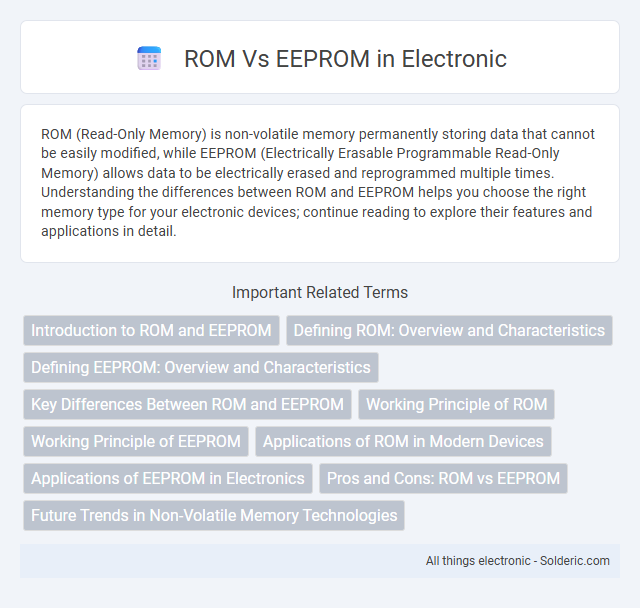ROM (Read-Only Memory) is non-volatile memory permanently storing data that cannot be easily modified, while EEPROM (Electrically Erasable Programmable Read-Only Memory) allows data to be electrically erased and reprogrammed multiple times. Understanding the differences between ROM and EEPROM helps you choose the right memory type for your electronic devices; continue reading to explore their features and applications in detail.
Comparison Table
| Feature | ROM (Read-Only Memory) | EEPROM (Electrically Erasable Programmable Read-Only Memory) |
|---|---|---|
| Definition | Non-volatile memory storing permanent data, programmed once. | Non-volatile memory that can be electrically erased and reprogrammed. |
| Data Modification | Cannot be modified after manufacturing. | Data can be erased and rewritten electrically multiple times. |
| Usage | Firmware, boot loaders, permanent system code. | Storing configuration data, calibration constants, small data patches. |
| Speed | Faster read access compared to EEPROM. | Slower read/write speed due to erase/program cycle. |
| Write Endurance | Typically write-once. | Supports thousands to millions of write/erase cycles. |
| Data Retention | 10+ years, highly stable. | 10-20 years, depending on usage. |
| Cost | Generally lower cost per bit. | Higher cost due to reusability features. |
| Physical Form | Mask-programmed or PROM/EPROM variants. | Chip with capability for electrical erase/program cycles. |
Introduction to ROM and EEPROM
ROM (Read-Only Memory) is a type of non-volatile memory used to store firmware or permanent data in electronic devices, ensuring information remains intact even when power is off. EEPROM (Electrically Erasable Programmable Read-Only Memory) allows users to electrically erase and reprogram data, offering greater flexibility for updates and modifications compared to traditional ROM. Understanding these memory types helps you choose the right storage solution based on your device's need for permanence and reusability.
Defining ROM: Overview and Characteristics
ROM (Read-Only Memory) is a type of non-volatile memory used primarily for permanent data storage in electronic devices. It retains data even when power is turned off and typically contains firmware or system software essential for device operation. Your device relies on ROM for essential startup instructions and basic input/output functions critical to its performance.
Defining EEPROM: Overview and Characteristics
EEPROM (Electrically Erasable Programmable Read-Only Memory) is a non-volatile memory type that allows data to be electrically erased and reprogrammed at the byte level, unlike traditional ROM which is read-only after manufacture. It stores firmware or small amounts of data that require frequent updates without losing information during power loss. EEPROM's ability to endure thousands of write-erase cycles makes it ideal for applications like embedded systems, microcontrollers, and configuration settings.
Key Differences Between ROM and EEPROM
ROM is a non-volatile memory primarily used for storing firmware, with data permanently written during manufacturing, making it read-only and immutable under normal operation. EEPROM, or Electrically Erasable Programmable Read-Only Memory, allows data to be electrically erased and reprogrammed, enabling multiple write and erase cycles without removing the chip. The key differences include ROM's fixed data storage for permanent code storage versus EEPROM's flexibility for small-scale, dynamic data updates, with EEPROM having slower write speeds and higher cost per bit compared to ROM.
Working Principle of ROM
ROM (Read-Only Memory) operates by storing data permanently during manufacturing using fixed semiconductor technology, allowing the stored information to be read but not altered. The working principle relies on predefined circuits and logic states embedded in hardware, enabling quick and reliable data retrieval on power-up without requiring external power to maintain the information. Unlike EEPROM, ROM does not support electrical reprogramming, making it ideal for firmware storage and system bootloading tasks.
Working Principle of EEPROM
EEPROM (Electrically Erasable Programmable Read-Only Memory) operates by storing data in floating-gate transistors that can be electrically programmed and erased at the byte level, allowing selective rewriting without removing the chip from the circuit. Unlike traditional ROM, EEPROM uses Fowler-Nordheim tunneling to apply high voltages to trap or release electrons in the floating gate, modifying the transistor's threshold voltage and thus changing the stored data. This precise electrical erasure and reprogramming enable EEPROM to support multiple write-erase cycles with greater flexibility and convenience compared to pre-programmed, non-volatile ROM.
Applications of ROM in Modern Devices
ROM is widely used in embedded systems for storing firmware and bootloader programs, ensuring reliable device startup. It is essential in gaming consoles and smartphones for storing permanent system software that rarely changes. Additionally, ROM serves as a secure storage medium in medical devices and automotive electronics, where data integrity and fast access are critical.
Applications of EEPROM in Electronics
EEPROM is widely used in electronics for storing firmware, configuration settings, and calibration data that must be retained without power and updated frequently. Unlike ROM, which is typically read-only and fixed during manufacturing, EEPROM allows your devices to modify stored data electrically, enabling flexible and reliable memory management in embedded systems, microcontrollers, and consumer electronics. Key applications include BIOS storage in computers, smart card data retention, and non-volatile memory in various sensors and communication devices.
Pros and Cons: ROM vs EEPROM
ROM offers fast, non-volatile memory with reliable data retention and low cost, making it ideal for permanent firmware storage; however, its content is fixed after manufacturing, limiting flexibility. EEPROM allows electrical reprogramming and data updates without removing the chip, providing greater adaptability for applications requiring occasional memory changes, but it has slower write speeds and finite rewrite cycles that may impact longevity. Your choice depends on whether you prioritize permanence and speed (ROM) or reprogrammability and flexibility (EEPROM).
Future Trends in Non-Volatile Memory Technologies
Emerging non-volatile memory technologies like MRAM, ReRAM, and PCM are set to surpass traditional ROM and EEPROM by offering faster write speeds, higher endurance, and greater data density. These advancements promise significant improvements in energy efficiency and storage reliability, critical for next-generation computing and IoT devices. Your choice of non-volatile memory will increasingly rely on these future-ready solutions to meet evolving data retention and performance demands.
ROM vs EEPROM Infographic

 solderic.com
solderic.com